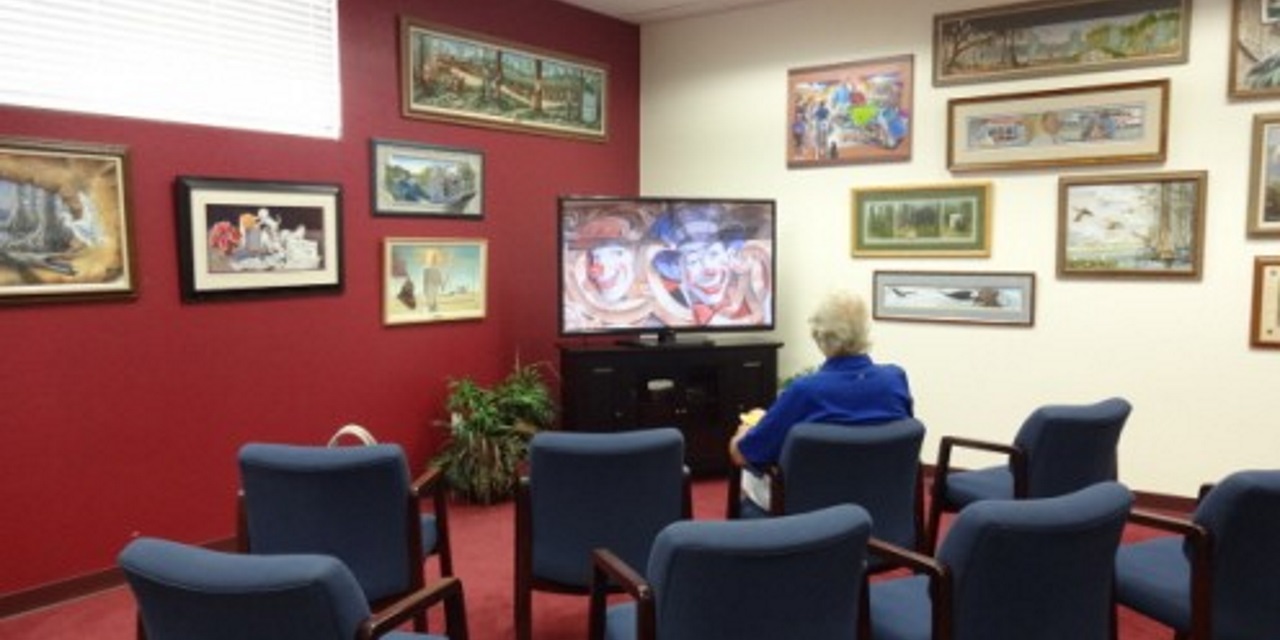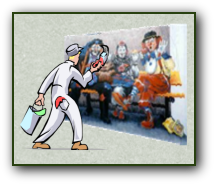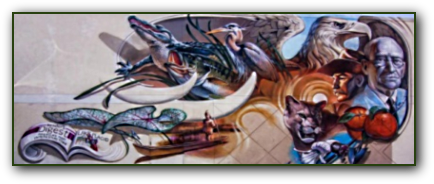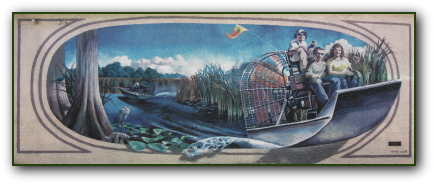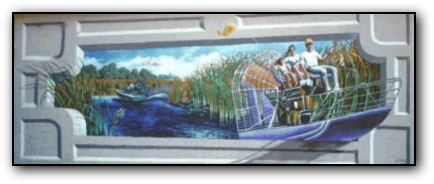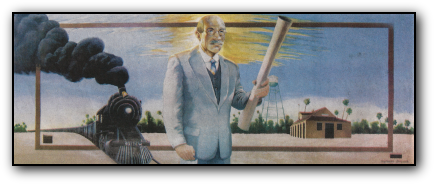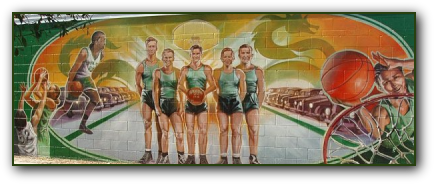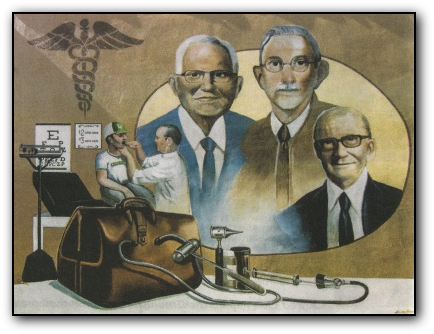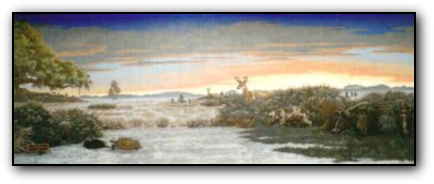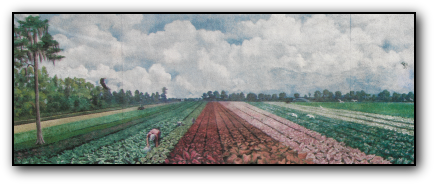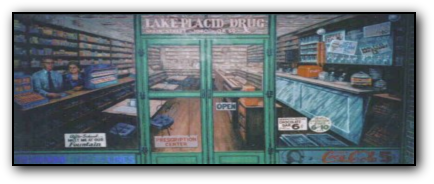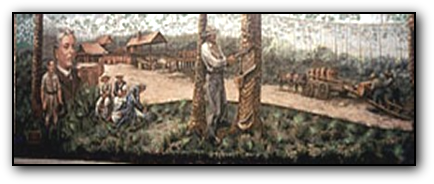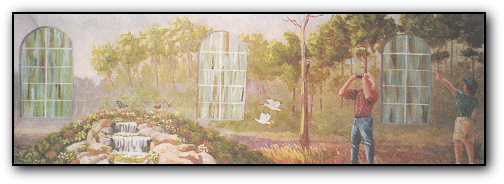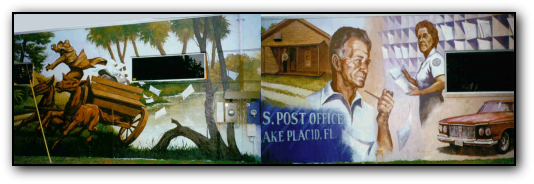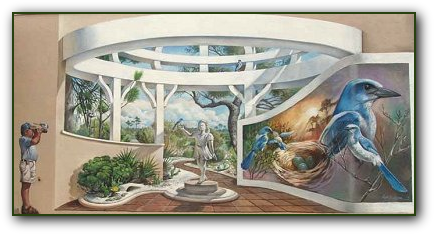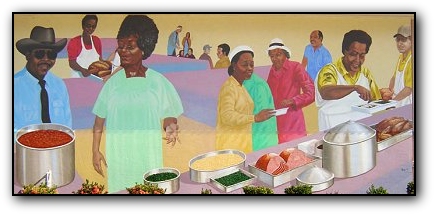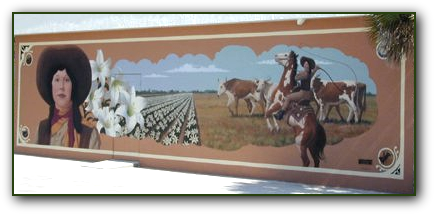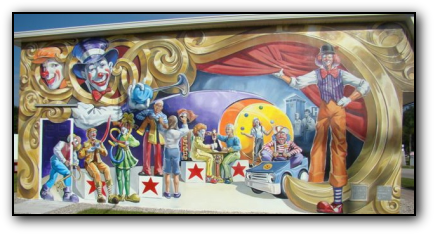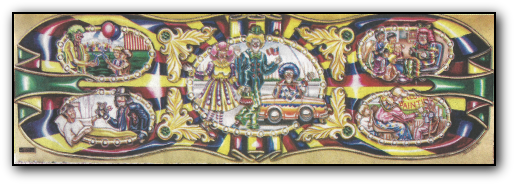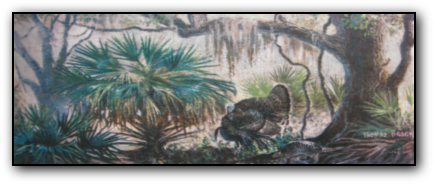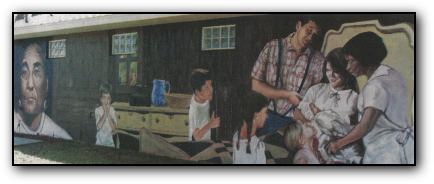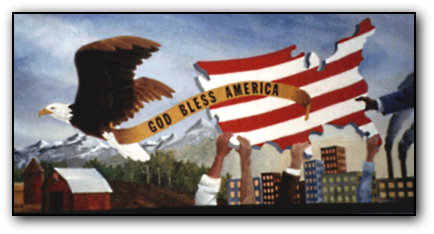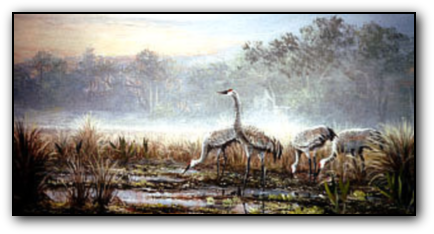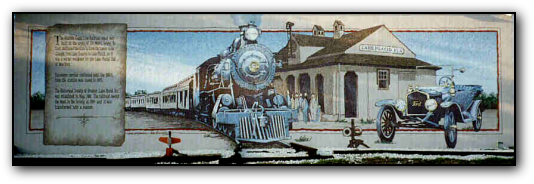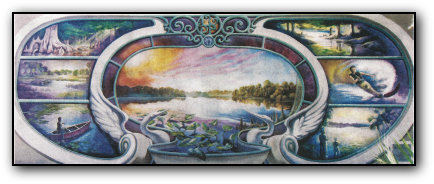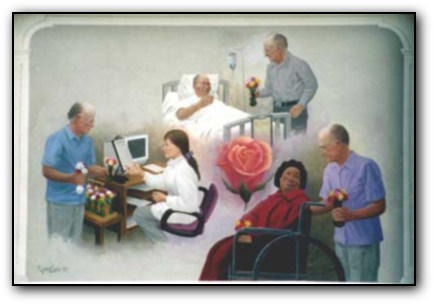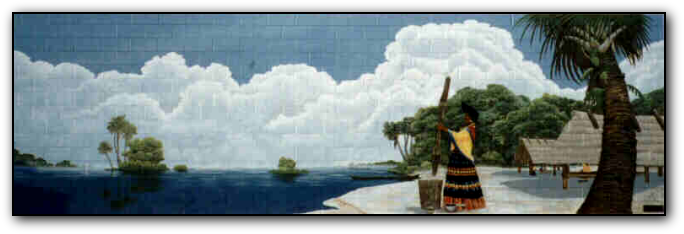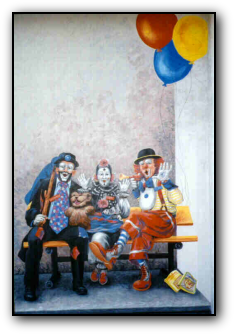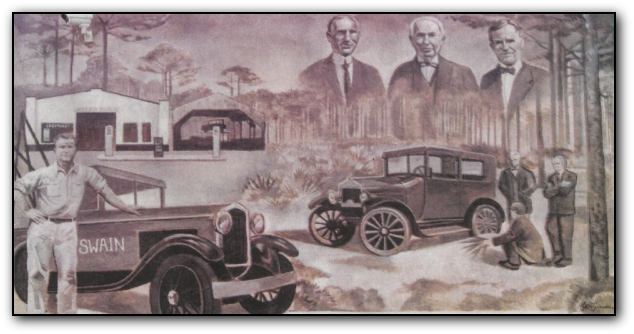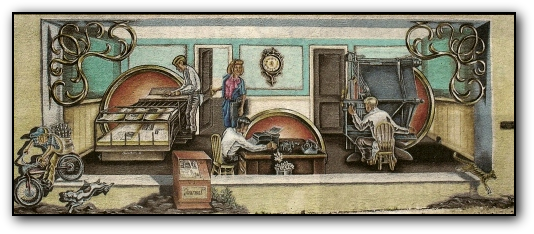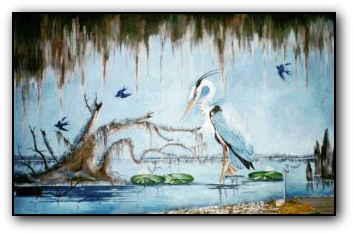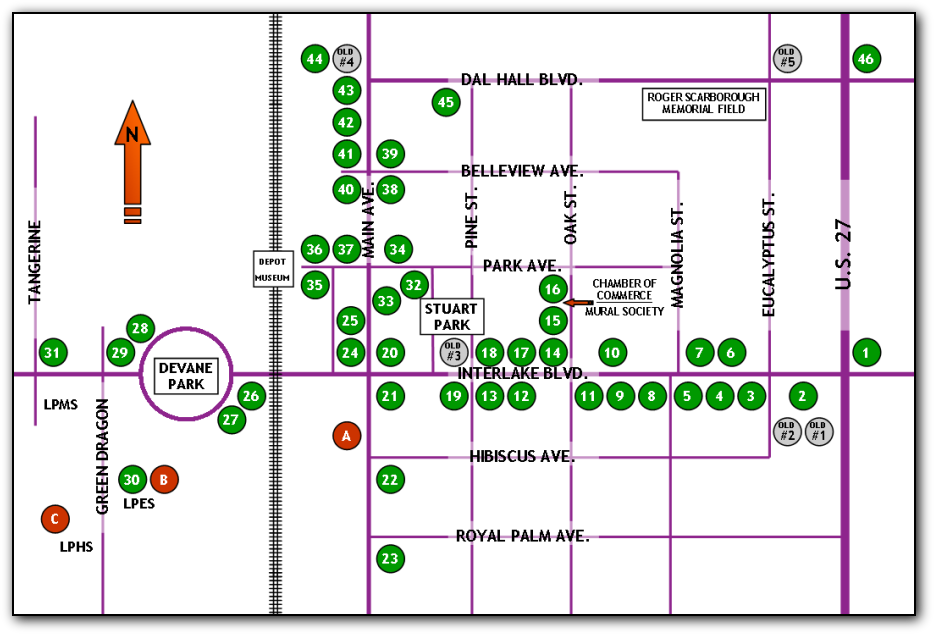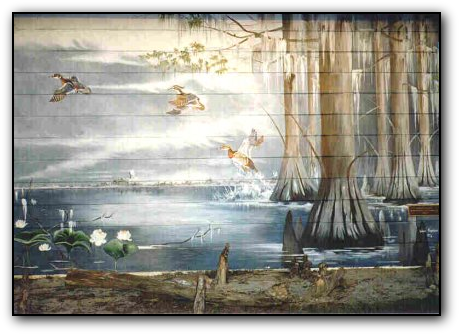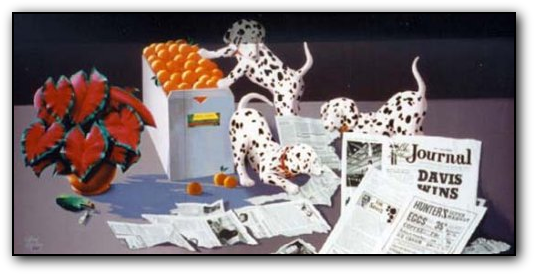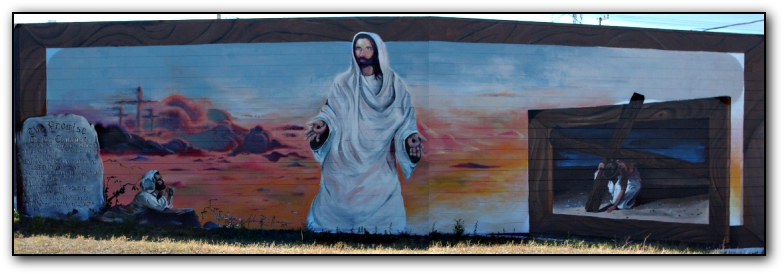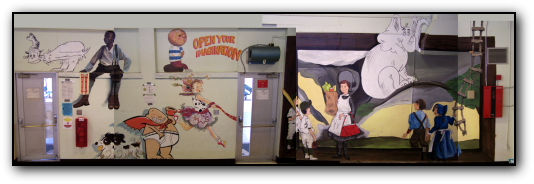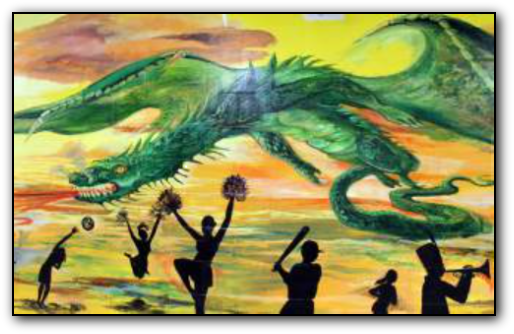1 Cracker Trail Cattle Drive
Location
Winn-Dixie
C.R. 621 & U.S. 27
Cracker Trail drives traveled just north of Lake Placid on what is now Route 98 Cattle were lean and would lose 200 to 300 pounds on a drive Registered brands you see on the cattle all belong to Highlands County cattlemen
Listen to the yips, moos and thunder as the Cowmen drive a herd of cattle through the Lake Placid area on their way to market. It was a two to three week trip and full of danger. Only the strongest would survive. Storms took their toll on cowmen as well as the cattle. They feared these storms because, not only could it stampede a herd, but also the lightening could kill. Often these cattle were driven to a deep-water port, and shipped to Cuba where cattlemen received gold. The cattle were lean, as it was not uncommon for them to lose 200 to 300 pounds during the drive. At that time there were no roads across the state and it was just a trail. The life of the Florida cowmen was not easy as they battled the heat, insects and storms.
The name "cracker" comes from the cracking of the whips the cowmen carried to keep the herd together. The registered brands you see all belong to Highlands County cattlemen. Highlands County ranks high in the production of beef cattle in the eastern United States.
Size
175' x 30'
Sponsor
Noon Rotary Club
Highlands County Cattleman's Association
Completed
June 3, 1995
2 America's Most Interesting Town
Size
46' x 20'
Sponsor
Walgreens Drug Store, Lake Placid
Location
Walgreens
U.S. 27 & Interlake BLVD.
Completed
August, 2013
In 2013, Reader's voted Lake Placid "America's Most Interesting Town"
This mural is a collage of several parts of the murals of Lake Placid
Lake Placid is 1 1/2 miles square with approximately 1,800 residents
Drum roll please! LAKE PLACID IS THE GRAND PRIZE WINNER! In 2013, Reader's Digest voted Lake Placid "AMERICA'S MOST INTERESTING TOWN". We are very proud to have this title and it inspired this beautiful mural 'Celebrate Lake Placid'.
This mural is a collage of several parts of the murals of Lake Placid. It embodies much of what Lake Placid is all about and what makes it so interesting. The lakes, the citrus, the caladiums, our endangered species, the cowmen, the indians and Dr. Melvil Dewey who invented the Dewey Decimal System, and in 1927 named Lake Placid after his beloved Lake Placid in New York.
What makes Lake Placid, Florida unique among towns? This small town is one and a half miles square and has approximately 1,800 residents. It is nestled in the center of the state among rolling hills of Highlands County on the Lake Wales Ridge.
Lake Placid has the distinction of known by many titles. It is known as Town of Murals, with 46 larger-than-life historic murals forming an outdoor art gallery. Lake Placid is the Caladium Capital of the World, where 95% of the world's caladiums are grown and shipped all over the world. The title of Florida's Outstanding Rurasl Community was earned by the mural society in 1996. The 27 beautiful pristine that surround the town within seven miles give Lake Placid the title of Florida's Lake Country.
Lake Placid has the distinction of having more clowns per capita than any town in Florida, or for that matter maybe the country. This is due to the American Clown Museum and School, which graduated over 2,500 clowns since its beginning in 1993.
The murals of Lake Placid are internationally known and have appeared in publications all over the United States, Canada and the world.
3 Airboat
Location
South Florida State College, Interlake BLVD. & Eucalyptus Ave.
Size
28' x 12'
Sponsor
Highlands Airboat Association
Completed
March 3, 1996
Highlands Airboat Association works with LAKEWATCH policing our lakes
Most airboats are made with an airplane engine and they 'fly' across the water
Fish and game officials routinely use airboats to reach remote or inaccessible lake areas
No other vehicle navigates our waterways with such ease. With nothing below the waterline except the smooth underside of the hull, these craft are environmentally friendly. In fact, scientists and fish and game officials routinely use airboats to reach remote or inaccessible areas of our waterways.
Floridian Glen Curtis built the first airboat in 1920 and called it, "the flying boat." By 1933, airboats were on the market. An airplane engine, stick, steering cables and rudder are airboat essentials, just as these parts are essential in most aircraft. And if it had wings, it would probably fly.
While airboats are used for recreation, the Highlands Airboat Association uses their airboats to help maintain our area lakes. Working in cooperation with LAKEWATCH, property owners, water management agencies and air boat association members spend hundreds of volunteer hours systematically policing litter and keeping tabs on otherwise unreachable parts of our lakes.
The association welcomes anyone who wants to join---with or without an airboat. And along with helping preserve our lakes, association members have a good time and throw monthly barbecues as an excuse to socialize. Airboat rides are also offered in this area.
NEW
OLD
4 Dr. Melvil Dewey
Artists
Roy Hampton
Terry Smith
Size
35' x 18'
Sponsor
Lake Placid Board of Realtors
Location
South Florida State College, Interlake BLVD.
Completed
March 6, 1994
Lake Placid, Florida and Lake Placid, New York are now sister cities. The two cities signed proclamations just in time for Lake Placid, Florida's 85th birthday in 2012. We are proud to be Lake Placid, New York's only non-Olympic sister city.
First time visitors sometimes remark Lake Placid lies in a rather remote part of Florida. Notwithstanding its two-hour-or-less proximity to 85% of the state's population, it still seems a bit out of the way. But don't let this remoteness fool you. We've had some pretty illustrious residents in our short century since Joshua Lastinger came over from Arcadia and discovered "the garden spot of Florida." Educator, librarian, developer, visionary, and Dewey Decimal System inventor, Dr. Melvil Dewey's legacy lives on. In 1895, Dewey built a summer resort for his wealthy friends at a place called Lake Placid, N.Y. About 35 years later he discovered a place he thought was well-suited for a winter resort for his wealthy friends. In 1927, he convinced the Florida state legislature to change the name from Lake Stearns to Lake Placid, and this town has never been the same.
He built a sprawling lodge on Lake Childs and had the lake's name changed to Lake Placid. He had the name of Lake Stearns changed to Lake-June-In-Winter. He convinced the railroad to build a new depot. He added another hotel in town, built a water tower, and maintained his own beautification project. The Atlantic Coastline Railroad Depot is on the National Registry of Historic Places and is also home to the Lake Placid Historical Society.
Dewey died the day after Christmas, 1931. The funeral service was held in the Lake Placid First Presbyterian Church. His ashes were returned for burial in Essex County, N.Y.
Dr. Dewey was an educator at the age of 17 and invented the Dewey Decimal System at 21
In 1895 he developed the L.P. Club in L.P., N.Y. and later in 1927, started L.P. Club here
Renamed town Lake Stearns to Lake Placid and had the water tower and train station built
5 Decades of Green Dragon Basketball
Location
The Rhodes Law Firm on Interlake BLVD.
Size
31' x 10'
Sponsor
The Rhodes Law Firm, Lake Placid Athletic Asociation and more.
Completed
December 30, 2008
Alfred Eide named the Green Dragon basketball team in 1939
They played all home games outdoors on a cement tennis court
At night, automobiles would surround the court to provide light for the game
Players: L to R - Roy Henderson (Center), Barney Smoak (Forward), Al Eide (Forward), Howard Eide (Guard), “Jr.” Guess (Guard)
Left: Shonda Callahan played 1981-84 and is now Head Coach of LP Lady Dragons
Left: Leonard Callahan representing present day LP Green Dragons
To find the origins of the Green Dragons, you must go back in time to 1939, when gas was 8 cents a gallon, WWII was making headlines, and Al Eide, a very athletic young man, was a senior at Lake Placid High School. In those days, classes were small, and Al Eide and about thirteen other boys wanted to play football. Their athletic coach feared they could not get enough players for a team, so he suggested they play basketball. All the boys agreed, and fourteen boys joined the first team. Now, number one on the agenda was to pick a name for their team. The boys suggested several names, but Al Eide was now the team captain, and the boys gave him the job to come up with a team name. Al studied the Boxer Rebellion in history class that year and because of his interest in the subject, Dragons were on his mind. The Avon Park basketball team sported the name Red Devils, and the Sebring team the Blue Streaks. LPHS colors were green, so Al put these two names together and came up with the Green Dragons. They submitted the name to the LPHS administration, and they approved the name.
Green Dragons played in the Ridge Conference against Avon Park, Frostproof, Fort Meade, Sebring, Okeechobee and Mulberry, and went 12-8 in basketball in 1938-39. They followed this with an outstanding 15-3 record the next season.
They always assigned the opposition’s best scorer to Eide, when they determined whom that was. Eide would keep him from scoring. They struggled a little on offense, but they played very physical defense.
In those days, there was no shot clock and the Green Dragons played their games on the old city tennis court, at what is now Bishop Park. They played outdoors at night. Spectators would pull their automobiles facing around the court and they played their games under the stars by automobile light. They drew good-sized crowds, and during the game, they passed the hat for admission. It was dangerous playing on cement, and many of the opposing teams would wear kneepads and elbow protectors, but not the Green Dragons, they were “country boys” and they thought those who wore them were sissies.
6 Honoring Early Physicians
Location
Precision Hearing Institute
on Interlake BLVD.
Size
15' x 12'
Sponsor
Lake Placid
Mural Society
Completed
January, 2015
NEW
OLD
These three doctors were beloved by our community. This was the time when you could have an office visit and pay $2.00 - $3.00 for a house call. Dr. Alfred Eide served from 1930 to 1941, Dr. D.W. Crankshaw arrived in 1948 and Dr. Norman Tylar arrived in 1959.
It's difficult to have much heritage and history if everyone gets sick. Finding doctors willing to practice in a remote rural area has never been easy. Fortunately, three outstanding physicians spent many years caring for our residents.
Dr. Alfred Eide devoted 11 years of service from 1930 to 1941. Born in Morris, Ill., and of Norwegian descent, Eide served several leading Chicago hospitals before moving here. He is remembered for performing lab tests and mixing and dispensing his own drugs, all for a $2 fee. If he had to make a house call, he charged $3.
A pioneer of holistic health, Dr. D. W. Crankshaw believed treating an ailment required treating the entire person. A graduate of the University of Michigan, he received his Doctor of Medicine degree in 1913. He practiced medicine in Michigan and on the Outer Banks of North Carolina. He and his unique approach to medical treatment arrived in Lake Placid in 1948.
For more than 25 years, Dr. Norman Tylar cared for Lake Placid's medical needs. Born in Birmingham, England, his father sent both Norman and his brother to the United States for their education. Tylar received his degree in medicine from Georgetown University and interned in Brooklyn, N.Y. His first practice was in Tampa. In 1959, he came to Lake Placid. One of his pet projects was the physical well-being of high school athletes. Anyone participating in sports received a regular free examination.
7 Prairie Dwellers
Artist
Guy LaBree
Location
G & N Developers, Interlake BLVD. &
N. Magnolia Ave.
Size
38' x 8'
Sponsor
Morning Rotary Club
Completed
March 30, 1995
These are some the the animals that live harmoniously on the prairies near Lake Placid
Wild hogs feed on a variety of roots and tubers, grasses, berries and small animals
The Southern white-tailed deer are smaller than the northern deer, weighing 75 to 100 lbs.
This pastoral setting caught the attention of Spanish explorers who traveled these wetlands and the rolling hills centuries ago. Our broad prairies flatten away from the Lake Wales Ridge and house a wide variety of life, sharing an ecosystem unsurpassed.
Guy LaBree captures this mood in his sunset on the prairie. Under a live oak tree a flock of wild turkeys stands against the deepening tones of the sky. A regal white-tailed deer seems to be the star of the evening's show; and wild hogs root for food.
LaBree's work includes an endearing and endangered creature - the gopher tortoise. These mild-mannered animals go ponderously about their business bothering few people. They like to eat aquatic plants, but they live on dry land---a true tortoise. And then, there is the burrowing owl that really does burrow.
LaBree knew capturing all the wildlife here would overflow a natural scene. But the rest of them are on that prairie---Florida panther, fox squirrels, rattlers and indigos. Alligators, too.
Even though they are an immense part of our heritage, there are simply too many animals to list or paint.
8 Caladium Fields
Artist
Tom Freeman
Location
Lockhart Service Center on Interlake BLVD.
Size
60' x 30'
Sponsor
Happiness Farms
Completed
November 1995
Lake Placid is the Caladium Capitol of the World where 95% of the world's caladiums grow
Annual Caladium Festival draws thousands of people to see the acres of color in the fields
Most Caladiums grow in 1,500 acres of black lake bottom muck on C.R. 621
"When God finished creating flowers, he turned a flower into a leaf," someone said. Brought here from the Amazon River Valley of South America, these beautiful leaf plants have become a thriving and important local industry.
The annual Caladium Festival draws crowds each fall when these fascinating plants are in "full bloom"---when their leaves are a rainbow of hues filling acres with color rivaling the tulip fields in the Skagit Valley in Washington.
The first bulbs were planted here more than half a century ago. Since then, the caladium industry cultivates more than 1,300 acres. The bulbs are shipped nationwide, especially to southern states and overseas to South Africa, Turkey, Spain, Pakistan, and all over Europe.
A large area of caladium farming spreads across the rich dark soil south of Lake Istokpoga. You can see these fields by traveling east on County Route 621. In late summer and early fall when the crop is mature, the wide-ranging landscape is a tapestry of bright red, pink, and white and all the shades in between.
Take some caladium bulbs with you and enjoy these highly decorative plants around the yard or grown in pots placed on a patio, deck or in a window.
By the way, our caladium growers supplied thousands of plants that helped decorate Atlanta for the '96 Olympics.
9 Lake Placid Drug Store
Artist
John Gutcher
Location
Rezultz Fitness
on Interlake BLVD.
Size
12' x 7' 8"
Sponsor
Lake Placid Drug
Completed
November 15, 1994
In 1925 Lake Placid had electricity only from 6:00 p.m. to midnight
Mrs. Crews was well known for her home cooking served at the soda fountain
Doc Crews treated many common illnesses of man and beast
Did you ever hang out at the local drug store's soda fountain? You weren't the only one. But our mural remembers a drug store featuring the irresistible fragrance of homemade pies and home cooking.
This mural depicts the oldest drug store in town.
In 1925, Lee Crews opened Lake Placid Drug. A year later he married Lillian Dean, an elementary school teacher and one heckuva cook. Back then, "Doc" Crews compounded most of his prescriptions. He made suppositories, powders, syrups, and elixirs from raw chemicals. He treated both man and beast, often summoned from home in the middle of the night.
This mural remembers a drug store that went through a fire some 50-or-so years ago, that served as an agency of both the Florida Motor Lines and Greyhound, and then moved to its present location in the 1950s.
The business has spanned three generations. Charlie and Dee Dee Stidham bought Lake Placid Drug around the mid-1960s. Their son, Dean, joined the pharmacy in 1982.
10 The Lost Bear Cub
Artist
Terry Smith
Location
Tony's Barber Shop on Interlake BLVD.
Size
46' x 13.5'
Sponsor
Tropical Harbor Homeowners Association
Completed
March 6, 1997
Lake Placid was once the best bear hunting territory in the country
The bears had plenty of berries, acorns, yellow jacket and bee nests and they grew fat
The first hunters killed 34 bear and some people in our history have killed over 200 bears
Lake Placid was once one of the best bear hunting grounds in Southern Florida. The territory around Lake Istokpoga and south along the western edge of the sand hills was almost too thick to penetrate by man or dog. This presented a perfect haven for bears to raise their young. The area was rich in palmetto berries and acorns; everywhere there were yellow jacket and bumblebee nests along the bay gall; acres of huckleberries and blueberries. There was always plenty to eat and bears grew fat.
When settlers moved into the area they brought cattle and razorback hogs. Unfortunately, the bears liked fresh pork and beef, and, out of necessity the pioneers became bear hunters. During the first hunt 34 bear were killed: and some of the old timers boasted of killing over 200 bears during their lifetime. The meat was excellent eaten fresh, salted, jerked or dried and bear grease far surpassed hog lard for cooking. It took a great deal of nerve to stand directly in front of a large black bear running through the dense woods directly at you and take a shot.
Occasionally a mother bear was killed and left several unattended cubs. The cubs were sometimes taken and kept for pets and they became very friendly.
11 Turpentine Industry
Artist
John Gutcher
Location
Signature Floors
Interlake BLVD. &
S. Oak Ave.
Size
62' x 14'
Sponsor
Family of Walter Coachman
Completed
September 11, 1994
A chipper removes bark and cuts a pattern called a "cat face" and inserts a metal strip
The gum drains into a seamless clay pot and is collected and taken to the distillery
Consolidated Navel Stores owned more than two million acres of Florida pine forest
The next time you're in a game of trivia with a Lake Placid resident, drop the name Walter Coachman, and see if anyone knows who he is. Coachman and a man named W. T. Sessions probably did more than any others to create jobs in this area around the turn of the century. Their industry was turpentine and their customers included owners of wooden ships that required pine gum caulking for their vessels.
Thus was born Coachman's Consolidated Navel Stores that owned more than 2 million acres of the state's finest pine forests. In camps recalled by this mural, and scattered throughout this region, workers collected gum that was distilled into turpentine widely sold across America.
The extraction process is shown as a worker, known as a "chipper," removes bark and cuts a pattern called "cat faces." The Bark was so strong, virgin trees sometimes required two chippers using the same axe to reach the gum. Inserted into the gash, a metal strip served to direct the gum into clay Herty pots. The pots were emptied into barrels that were lifted onto wagons drawn by mules to the stills where turpentine was refined.
Coachman became a prime developer in this area. Consolidated remains a leader in real estate and agricultural development. Members of his family still call Lake Placid home.
12 Layers of Time
Artist
Dean Quigley
Location
Heartland Finacial Group on Interlake BLVD.
Size
89' x 16'
Sponsor
Gate Petroleum
Completed
December 1998
This mural takes us back in time 10,000 years when Mastodons roamed our area
There are Indian mounds in Lake Placid dating back for 10,000 years
The third panel shows archeologists digging beyond written records to reconstruct the past
Migratory Paleo-Indians moved into Florida about 12,000 BC. Evidence indicates they were present here as early as 7,000 - 9,000 B.C.
The mural shows Indians closing in on a mastodon. The animal's trunk is raised to deliver a shrill trumpeting while the hunter raises his atlatl (throwing spear). Other hunters hide in the grass ready for the kill. Florida's landscape was considerably drier than today's. The coastline was about 100 miles further into the Gulf of Mexico. Large grassy plains dominated the landscape and tree hammocks clustered around water holes providing a drinking source.
The second section shows the same site several thousand years later when the rising sea level, and a wetter, warmer climate provided a diverse food supply and a far different environment. The bow and arrow became a chief hunting tool.
Indian culture evolved into village settlements. This change included ritual building of ceremonial and burial mounds and long distance trade arose with cultures as far away as Missouri.
The design in the center is a replica of a small silver ceremonial tablet found in the Goodnow mound near Lake Josephine. The owl totem effigy is the largest wooden totem found in Florida. When the Europeans entered Florida in the 1500s, their presence brought about profound changes to native tribes. Epidemic disease, enslavement, and warfare obliterated the state's true natives.
13 Birding
Artist
Thomas Brooks
Terry Smith
Location
Lake Placid Christian School on Interlake BLVD.
Size
67' x 12'
Sponsor
Harry Wood in memory of Edythe Wood
Completed
2003
In December, volunteers gather to take an annual Christmas bird count in Highlands County
Florida has the third greatest number of different bird species of any state in the nation
Thirty-six species of birds are officially listed as endangered in Florida
On the state birding trail, Highlands County offers sanctuary to more than 300 winged species watched by thousands of birders who either live or visit here. Because of its natural environment of lakes and woods, the Lake Placid area and the rest of the Lake Wales Ridge is home to these birds and many of the birders who seek them.
Though a century old, birding has become a recent phenomenon, promoted by ornithologist Frank Chapman who set out to put an end to the wholesale Christmas bird slaughter that had become a national holiday pastime. Chapman thought it made more sense to count birds than it did to kill them. Until then, holiday celebrators formed teams and the team that had the largest pile of feathers at the end of the day, won. Thanks to Chapman's ingenious idea and the couple of dozen people who agreed with him, Christmas 1900, counted more than 90 bird species scattered from Ontario to California.
Some birders organize for the annual Christmas Bird Count, but birders are also curious people who hear a bird song and step closer to catch a glimpse of the singing bird, maybe to see it and, using what they know or what they find in a book, try to tell what kind of bird is singing there in the lofty oak branches, the melodic song drifting through the swaying Spanish moss. This fascination people have with birds becomes even more interesting when we remember that scientists thick they are the vestiges of the ancient reptilian era. After all, a "birder" is anyone who steps outside to see what kind of bird is singing that song in that bush or tree. A birder could be you or me.
14 The Old Post Office
Artist
(new) Keith Goodson
(old) Richard Currier
Location
Welcome Center on N. Oak Ave.
Size
70' x 14.5'
Sponsor
Jeanette Hoy, Bob & Debbie Graves
Completed
November 2015 (new)
This building is one of nine locations where the post office has been since 1919
The mules carried the mail from Arcadia in 1919 and were watered at Buck Lake
The mules bolted and the wagon, mail and mules went to the bottom of the lake
It was supposed to have been a routine mail delivery. After all, on a regular basis mail was transported from Arcadia to Lake Placid and back, two days each way. It took a couple of mules pulling a wagon to get the job done.
Along the way, and about four miles south of the Lake Placid Post Office, small Buck Lake was a great place to stop and let the mules get a drink. So, there wasn't any reason for the mail carrier to be concerned. But on this particular day, something frightened the mules and they bolted. The whole rig, the mail and the mules all plunged into the lake that reaches over 60 feet at its deepest. Divers say what remains of that accident lies at the bottom of Buck Lake to this day.
This mural commemorates that tragic event. But it also honors John J. Hoy, Lake Placid Postmaster for 19 years, beginning in 1953. He saw the first canceling machine arrive and a year later, a postage meter was installed. He served as president of the National Association of Postmasters, Florida Chapter. Daisy Shackelford was his postal clerk.
Our first post office was built in a day. On February 5, 1919, folks brought their drygoods boxes and constructed the office over by the railroad depot. Two years later, Angus McAuley got the post office moved into his store and became postmaster. The following year, in February, postal service was handled out of the Arcade Hotel at Interlake Boulevard and Main Street.
While Hoy was postmaster, the building that hosts this mural was built in 1963. The Old Post Office building now houses the Greater Lake Placid Chamber of Commerce Welcome Center, the Mural Society, and the Lake Placid Board of Realtors.
OLD
NEW
15 Town of Murals - How It All Began
Size
20' x 13'
Sponsor
Friends of the Porters
Completed
unknown
Location
Welcome Center
on N. Oak Ave.
Bob and Harriet Porter founded the mural society in 1992
The society placed 142 pieces of artwork in town, which includes over 33,000 sq. ft. of murals
Tourism increased and has a positive economic impact on the town
In this mural, founders of the Lake Placid Mural Society, Harriet and Bob Porter look back on 20 plus years of the Society’s history. For six years after they retired they traveled throughout the United States and Canada for 3 months each summer on their Gold Wing motorcycle, often logging up to 18,000 miles.
On their last long trip, they came through Vancouver Island, B. C., where they saw a cutout of a woodsman with a pallet in his hand that said “Chemainus, The Little Town That Did.” Curiosity got the best of them and they decided to see what this little town did. They were delighted when they found 32 larger than life murals depicting the history of Chemainus. Further investigation found the murals fostered tourism and had brought this tiny town back from the brink of financial disaster. Shortly after leaving Chemainus, Bob made this statement; “We are going to paint murals in Lake Placid.”
In 1992, Lake Placid had 15 empty stores and black mould and mildew was evident on many of the walls in town. The Porters knew several artists and selected Thomas Freeman for the first mural, which he painted on the side of the Caladium Arts and Crafts Cooperative, also a new business and the brain child of Bob and Harriet. In 2014, the number of historic murals grew to 46.
Since its beginning, the mural society placed 142 pieces of artwork in town, which includes over 33,000 sq. feet of murals. There are over 140 towns and cities across the U.S. and Canada that have requested information to start their own mural project to help revitalize their towns. All the money for the murals is earned solely by fundraisers, sponsorships, and donations.
During these years, tourism increased, which has had a positive economic impact. Lake Placid became known as the Town of Murals, and Florida’s Outstanding Rural Community. In 2013, Lake Placid Florida won the coveted title of “America’s Most Interesting Town,” in a nation-wide search by Reader’s Digest. Ten towns were finalists in this contest, and in the end, Lake Placid stood out among the rest. It is truly a jewel in the crown of Highlands County. The sponsors, Friends of the Porters, arranged this mural as a surprise for the Porters and as a thank you for their 20 years of service to the community.
16 The Scrub Jay's World
Size
27' x 13.5'
Sponsor
Oak Island
Homeowners Association
Completed
February 2006
Location
Winn-Dixie
at N. Oak Ave. & Park St.
Florida scrub jays are on the federal endangered list and live only in the scrub oak
These jays are very friendly & will beg peanuts by sitting on your hand, head or shoulder
Only the established breeding pair mates; all others help raise the offspring
Lake Placid welcomes you to the world of the Florida scrub jay. This threatened, unique little bird is a bird all its own and it is found only in the Sunshine state and the Lake Placid area.
Florida scrub jays love peanuts; in fact, they love them so much, all you have to do is stand with a peanut on the palm of your hand. They will swoop down and sit on your head, shoulder, or hand. In a second, they will land on your hand, grab the peanut and off they go to bury it in the sand. Then, they are back for more. If you give them a choice of peanuts, they are just like people; they will choose the biggest and the best.
The Florida scrub habitat, where the scrub jay lives, is one of the most endangered ecosystems in all of North America. Urbanization is destroying and fragmenting the scrub jay habitat, while other factors such as pesticides, busy roads, and house pets become a serious threat to the jays’ reproduction and survival. They are faithful to their original territory and once that territory is destroyed, they do not relocate.
They mate for life. A breeding pair establishes a territory of about twenty-five acres, which they protect from other jays and predators. They build a nest, which looks like a shallow basket of twigs and palmetto fibers, about eight feet above the ground and raise one or two broods from clutches of three to four eggs in a year.
The hatchlings stay around to help feed the next brood and stand watch for predators. They always post a sentinel high in a tree to watch and sound an alarm when a predator enters their territory. Families stay together in the same territory for many years.
They like to eat acorns, of course; a single jay is likely to consume over 7,000 a year. Lots of other food is available in the scrub woods---berries, seeds, insects and spiders, even tree frogs, lizards and small snakes.
Scientists at Archbold Biological Station, eight miles south of Lake Placid, carefully watch this endangered species. On-going scrub research has spanned nearly sixty years of our history and continues today. The state of Florida and some private conservationist groups are setting aside as much scrub woods as possible to help ensure that this friendly little ambassador continues to welcome visitors.
17 The Talk of the Town
Artist
Richard Currier
Size
60' x 11'
Sponsor
Donald & Dorothy Bates
Completed
2001
Location
Kelley's Florist
on Interlake BLVD.
A PBX board was used in Lake Placid from 1930 to 1935
Florence Nowling Booker was Lake Placid's Chief Telephone Operator from 1930 to 1935
Emily Dewey placed a call to Dr. Alfred Eide in 1931, after Dr. Dewey suffered a stroke
Lake Placid's phone exchange soon ready the headlines of a local newspaper declared on December 15, 1930. All the equipment is in place and sixty homes are wired and waiting to be "cut in."
Florence Nowling Booker worked for Intercounty Telephone and Telegraph Company in Ft. Myers and in 1930 transferred to Lake Placid to become the town's first and only PBX operator. Florence operated the PBX board during the daytime, and daughter Mildred Booker, a high school student, answered the night calls. In those days telephone operators were many things to many people. They were lifeline and the very heart of the community. The townspeople would call Florence and tell her where they were going and to please forward their calls. Then they called to tell her they were returning home. If you wanted to know anything, you called Florence.
The household telephone was a big wooden rectangular box hanging on a wall. A bakelite earpiece hung in a cradle on one side of the box. A mouthpiece was on the front and beside that was a crank.
The telephone office was a building with a raised floor on South Pine Street just one block off Interlake Boulevard. The back area was for living and the front housed the PBX board. The building stills stands.
The mural depicts a documented phone call between Dr. Dewey's wife Emily and Dr. Alfred Eide on December 26, 1931. Dr. Dewey aroused earlier than usual, Mrs. Dewey stated, and called her. They were discussing club matters when his talk suddenly became unintelligible. This was followed by a loss of consciousness. Dr. Alfred T. Eide was called. Dr. Dewey never fully regained consciousness.
18 "Captain' Theodore W. Webb
Artist
Richard Currier
Size
38' x 8'
Sponsor
Webb Family &
Jim Blackman Ford
Completed
January 1999
Location
Davis Chiropractic
on Interlake BLVD.
Capt. Theodore Webb was one of the first Caladium growers in the 1930s
He owned the first and only service station between Sebring and West Palm Beach
He sponsored the Golden Gloves Boxing Club, known as the Thursday Night Fights
So, where did all these interesting and beautiful plants called "caladiums" come from? Who discovered they grew so well here?
They came from the tropical Amazon River Valley of South America. One of the first caladium growers, Theodore Webb, discovered caladium bulbs while visiting Tampa. He brought some home, threw them in the ground and about 60 years later, caladiums are a multi-million dollar industry and the bulbs are sold around the world. It could be said that as tulips go with Holland, caladiums go with Lake Placid.
But Webb did more than cultivate his 10-acres of commercial caladiums in the 1930s. He opened the town's first service station in 1924, the only one between Sebring and West Palm Beach. His Studebaker was one of the first cars in town. He sponsored Golden Gloves boxing and built a boxing ring adjacent to the service station to give folks something fun to do or watch. It was called "The Thursday Night Fights."
As popular as he was around town for his boxing ring and his quality tires, Webb's heart was in horticulture. The town hired him to replant and recondition the public golf course where Tomoka Heights is today. He served on the town council the year the town changed its name from Lake Stearns to Lake Placid, thanks to Dr. Melvil Dewey. ( But that's another mural.)
Webb worked with new procedures transplanting and propagating native trees, shrubs and ornamental plants. He built a rock garden where DeVane Park gazebo now stands. He had the first certified Red Cross station in our area and instructed Red Cross First Aid and Water Safety Lifesaving to residents of Highlands County and the Brighton Indian Reservation. And, he was the town's first Boy Scout Scoutmaster.
19 Tea at Southwinds
Artist
Thomas Freeman
Location
Caladiums Arts & Crafts Cooperative on Interlake
Size
60' x 30'
Sponsor
Thomas Freeman
Completed
March 15, 1993
The Lake Placid Mural Society's first mural, "Southwinds," was dedicated on May 15, 1993
These were the glory days of Lake Placid where the rich and famous came to play
This was Dr. Melvil Dewey's "Litl Loj," later named Southwinds
Not long after Dr. Melvil Dewey passed away, his resort, Litl Loj, became known as Southwinds. By the standards of those times, Dewey's southern resort rivaled his northern resort at Lake Placid, N.Y.
These stylish ladies might have been a lot like Dewey's guests --- pretty, proper and primped. They were having tea on the luxurious patio of handmade Italian tiles. Their view from the patio was a long sweeping slope to the Lake Placid shoreline. It must have reminded them a little bit of home.
Southwinds is Lake Placid's first mural. It's an impression lifted from a postcard found at the Lake Placid Historical Society. But it was enough to get the mural project started in 1993.
In Southwind's day, fashionable ladies and sophisticated men sipped cocktails or tea and discussed the latest Broadway tunes; their present day counterparts stroll the mural tour and imagine how Lake Placid was back then.
In a word, it was grand for the celebrities from screen and stage and the famous physicians and businessmen basking in Dewey's seasonal sunshine. In the 1940s, Southwinds swung - It was party time! People vied with each other for the privilege of hosting these parties.
20 Lake Placid Country Fair
Artist
Connie T. Burns/Watkins
Size
108' x 18'
Sponsor
Wauchula State Bank,
Caladium Art & Craft Cooperative
Completed
February 1, 1996
Location
Mid-Florida Bank
at Interlake BLVD. & N. Main Ave.
The fair is held every year on the Saturday and Sunday of the first full weekend in February
There are over 200 arts and crafts booths and plenty of food and entertainment
Many local artists and craftsmen exhibit their work at Lake Placid Elementary School
Thousands of folks make plans to visit Lake Placid for the Country Fair, immortalized in this large mural at the crossroads of town---Interlake Boulevard and Main Street.
It's been over three decades since a small group of art enthusiasts created the Country Fair to show off their work. Mr. and Mrs. Cole Danley were the driving force behind the fair. The Coles proposed something like the fair they attended in Burnsville, N.C. Their proposal won local support and the Lake Placid Arts and Crafts Association was formed.
The first Country Fair was held only steps from this mural, on the front lawn of the Woman's Club on Main Street. As the fair grew, it soon spread out over Stuart Park and spilled into the Masonic Lodge and included several businesses. Eventually, it moved and embraced DeVane Park.
The two-day event draws thousands of visitors to town the first full weekend in February and has become one of the largest of its kind in the state. It has become so large that artists and craftsmen also exhibit their arts and crafts at Lake Placid Elementary School.
Through the years, band concerts, greased pig chases, pole climbing, barbecues, train rides, cloggers, continuous entertainment, watermelon and pie-eating contests have all been part of the fair.
21 Eddie Mae Henderson - Sharing & Caring
Artist
Charles Peck
Size
22' x 13'
Sponsor
Sharing and Caring & Friends
Completed
June 6, 2005
Location
Wauchula State Bank
at Interlake BLVD. & N. Main Ave.
For 20+ years Eddie Mae Henderson cooked Christmas dinner for the less fortunate
Eddie Mae and more than 25 volunteers serve over 500 dinners each Christmas
The L.P. community now contributes money and services to help with the dinner
It started with a dream in 1984, when Eddie Mae Henderson decided to offer her own local brand of help to those less fortunate at Christmas. On her own, without the backing of any local organization, Henderson prepared and served her first Christmas Day dinner at Stuart Park in Lake Placid. Her belief in God prompted her to act and no one, rich or poor, would be turned away. Thus began an over twenty-year tradition to provide a Christmas dinner to the less fortunate and needy in Lake Placid.
While the menu would vary from year to year there was always turkey, ham, stuffing, gravy, sweet potatoes, green beans, collard greens, and an assortment of pies and cakes, however the main ingredient was love.
As the number of guests at Eddie Mae's table grows, she now depends on donations from the community. Many volunteers, often more than twenty-five, come to the Masonic Hall off Main Avenue to serve more than five hundred dinners. Other volunteers deliver meals to the area's shut-ins. Donated toys are distributed to the children. Among those volunteers is a local businessman, Frank Hartzel, (seen in the upper right hand corner of the mural) who for many years has cooked sometimes more than fifteen turkeys each Christmas for Eddie Mae's bountiful feast. Eddie Mae is a member of the New Life Assembly and W.C. Holden , is Pastor.
Eddie Mae is more thankful for what she can give than what she receives.
Pictured from left to right, in the mural are: Elijah Smith, Eddie Mae in her youth, Eddie Mae today, Eugenia Moorehead, Eddie Mae's daughter, a participant, Leroy Sholtz Jr., Eddie Mae in mid-life.
22 Jennie Reninger - A Remarkable Woman
Artist
Roger Cooke
Size
50' x 10'
Sponsor
Personal Rehab, Vivian Zimmerman, The Parrish Family and Lake Placid Historical Society
Completed
January 2004
Location
Personal Rehab
on S. Main Ave.
Jennie took a challenge to ride a bucking bull in a rodeo and won $1.00 for her efforts
She rode alone for 2 months through the prairies that stretched as far as the eye could see
Her whip could take a cigarette out of your mouth, or strike a match from ten feet away
Jennie Reninger, born in Zion City, Illinois in 1903, was a remarkable woman, rancher, real estate broker, world traveler, founder director of a bank, newspaper reporter, tour director and in later life the Chamber of Commerce titled her Good Will Ambassador and Official Greeter in Maggie Valley, North Carolina.
She and her family lost everything in the great depression and lived in a one-room shack. Jennie went to work for a newspaper, increasing their circulation by 50%. She wrote a very popular column, "The Tattletale". Later a radio program titled "Just Jennie" aired. Jennie invested part of her wages in Cattle. During the 1930's and 40's, screw worms sucked the lifeblood out of the Florida cattle industry, also a disease known as "Salt Sick" caused by a deficiency of certain materials in the grass was almost as big a problem. For two years Jennie rode alone from daylight to after dark tending the cattle.
Jennie and her family founded the Easter lily industry in Lake Placid from a gift of fourteen bulbs. They multiplied into twelve acres of lilies and the Reningers went from rags to riches. Due to the war, Japan no longer imported lilies. Then disaster hit. Someone burned her barn and $30,000. worth of bulbs went up in smoke. A new grower brought in diseased planting stock and introduced "Fleck" to Highlands County, a virus disease that caused spotting. Then came the big freeze and the end of the lily business.
Toward the end of her ranching days Jennie purchased a fine herd of purebred Brahman cattle, which were her pride and joy. They grazed on her 63-acre ranch known as Green pastures. She lived to be 94 and enjoyed every minute of her life.
23 The Trail to Eagle Scout
Location
Home & Office Essentials
on S. Main Ave.
Size
40' x 8'
Sponsor
Mark & Jeanne Fortier
Completed
August 2007
Scouting in Lake Placid dates back to at least the 1940's
This mural is a tribute to all those involved in scouting at any level
Less than 4% of boys entering the scout program attain the rank of Eagle Scout
Scouting provides youth unparalleled opportunities to experience real life situations. Scouting challenges a boy with the basics of first aid, cooking, camping - all centered on building character and self-esteem.
Confidence gained as a Tenderfoot explodes as the rewards of self-motivation grow with each merit badge.
As the ranks progress to Second Class and First Class, so the challenge increases with map reading, wild life conservation, swimming, life saving, and leadership.
The ranks of Star and Life bring responsibility to not only the scout and troop, but to the church and community through service projects, leadership, and in bringing young scouts along the Trail to Eagle.
Many describe the Eagle Scout as “the all-around-perfect scout.” Becoming an Eagle Scout requires the mastery of skills and leadership, service, outdoor expertise, citizenship, and ethical behavior of the highest order. Fewer than 4% of boys entering the scout program reach this lofty status. This speaks to the high standards set for this earned honor. Eagle Scout is a lifetime achievement worn by some of America’s finest athletes, physicians, scientists, astronauts, business leaders, and presidents.
Lord Robert Baden-Powell (pictured in the mural) founded scouting in Great Britain in 1907. He was a general in the British Army who invited a group of boys to attend the world’s first Boy Scout camp. In February of 1910, Lord Baden-Powell brought Boy Scouting to America. Boy Scouts celebrate the birthday of scouting on the 8th of February.
This mural highlights two scouts of Troup 482 - Joe Hernandez and Todd Fortier. Joe Hernandez reached the Life Scout Rank, and Todd Fortier achieved Eagle, earned the bronze, gold, and silver Eagle Palms, and became a Junior Assistant Scoutmaster. Tragically, Joe and Todd were lost in separate vehicle accidents. We honor and remember both young men as they continue to “soar with the Eagles.”
